Paragenesis and geochornological studies of Asnawa Iron Ore by the isotope and mineral chemistry in Penjween Area, Zagros Suture Zone Kurdistan Region, NE Iraq
الموضوعات :
Kamal H. Karim
1
![]() ,
Nabaz R.H. Aziz
2
,
Al-Bidary Mayssa A.A.A
3
,
Nabaz R.H. Aziz
2
,
Al-Bidary Mayssa A.A.A
3
1 - Department of Geology, University of Sulaimani, Kurdistan Region, Iraq
2 - Department of Geology, University of Sulaimani, Kurdistan Region, Iraq
3 - Department of Geology,University of Baghdad, Iraq
الکلمات المفتاحية: Asnawa iron ore, Qulqula Radiolarian Formation, hornfels, skarn, Penjween mineralization, paragenesis,
ملخص المقالة :
The Asinawa iron ore is located about 3km to the southeast of Penjween town, Sulaimaniya Governorate, Kurdistan Region, Northeastern Iraq near the Iraq-Iran border. The exposed iron ore deposit is about 60 and 400m wide and long respectively. The present study is the re-study of the geology and geochemistry of the Asnawan Iron ore deposit and concluded that the country rocks are consist of hornfels in which the original lamination or banding of the parent rocks (calc-silicate low grade metamorphic rocks) are preserved and inherited from its laminated sedimentary precursors. Moreover, the facies that is associated with host rocks is hornblende-hornfels facies with temperature range of 550-650 oC. This range is confirmed through thermo barometry. There are evidences of localized pyroxene-hornfels and sanidine hornfels facies too. Additionally, the detail of the different stages of the iron ore paragenesis is shown by discussion with the aid of suitable graphical drawing and geochemical variation diagrams. By these methods, the sedimentary stratigraphic unit of the parent rock (protolith) was found for the first time which consists of Qulqula Radiolarian Formation (Kermanshah Radiolarites in Iran). The bedded chert, limestone and calcareous shale is the main lithology of the latter formation and after burial and deformation, it is regionally metamorphosed to banded and lamiated calc-silicate rocks of green facies rocks. At a later stage, these rocks, remetamorphosed (polymetamorphism pattern) again to hornfels with concurrent changing to iron ore by basic iron rich hydrothermal solutions during Eocene (37-40Ma). This age is calculated using Ar39/Ar40 method of dating.


